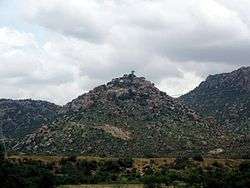Penukonda
| Penukonda పెనుకొండ Village | |
|---|---|
|
Chilla Pahad near Penukonda | |
 Penukonda Location in Andhra Pradesh, India | |
| Coordinates: 14°05′06″N 77°35′46″E / 14.085°N 77.596°ECoordinates: 14°05′06″N 77°35′46″E / 14.085°N 77.596°E | |
| Country |
|
| State | Andhra Pradesh |
| District | Anantapur |
| Elevation | 769 m (2,523 ft) |
| Population | |
| • Total | 20,220 |
| Demonym(s) | penukondavi |
| Languages | |
| • Official | Telugu |
| Time zone | IST (UTC+5:30) |
| Vehicle registration | AP |
| Nearest city | Hindupur |
| Vidhan Sabha constituency | Penukonda |
Penukonda or Penu Konda, is a town in the Anantapur district of Andhra Pradesh, India. It is 70 km away from Anantapur town. This town is different from similar-sounding Penugonda. This town contains approximately 365 temples built during Vijayanagara rule. It was the second capital of Vijayanagara kingdom.
Geography
Penukonda has an average elevation of 769 metres (2526 ft).
Demography
According to The Imperial Gazetteer of India,[1] Penukonda was a subdivision and taluk of Anantapur district in Madras province. It contains 96 villages covering an area of 677 square miles. The population in 1901 was 92,482, compared with 81,104 in 1891. Penukonda was the headquarters town with a population of 6,806. It is situated at the base of a large hill (Konda in Telugu language), from which it takes the name. It is a place of historical importance. It became the capital of fallen Vijayanagar monarch, after he was overthrown in 1565 at the Battle of Talikota. The Penner River flows along its western and Chitravati river along its eastern boundary.
Penukonda Fort
A famous medieval fort is located in the town.
History
This region was controlled at different points in history by the Hoysalas, Chalukyas, Vijayanagar, Nawabs, Maratha chieftain Murari Rao, Tipu Sultan, Nizam and eventually came under British rule after it was ceded to the British by the Nizam of Hyderabad.[2] It was a melting pot of different religions but the town and fort were established by early Hoysala kings, who were practitioners of Jainism.
After Krishna Deva Raya, Venkatapathi Rayalu, the Emperor of Vijayanagar, took over. He made Raya Dalavayi Koneti Naidu (son of Kasturi Naidu, grandson of Akkappa Naidu, great-grandson of Kanaka Naidu of Chandragiri), as the governor of Penukonda and conferred him the title with Maha-raja-raja-sri and celebrated Koneti Naidu's marriage to Swarna. Koneti Naidu ruled Penukonda, Rayadurga and Kundurpi Forts for about 17 years (1635-1652AD). After the ruling of Koneti Nayudu his descendants Raya Dalavayi Sri Venkatapathi Nayudu, Peda Timmappa Nayudu, Venkatapathi Nayudu, Koneti Nayudu, Rajagopala Nayudu and Timmappa Nayudu ruled this Penukonda country.
Because of its ancient Jain history and presence of many temples it is one of the most revered places for Jains. The famous Pache Parsvanath Swamy Temple, with idol of Parsvanath containing a single green coloured stone (Pacha) is located here.
The famous Babaiah Dargah makes this place venerable to Muslims as well. Hazrath Baba Fakruddin was a great Sufi Saint of 12th century. Purportedly before coming to Penukonda, he was a king of Sistan and Shahpur in Iran. Legend says that he was searching for a place to settle and his Guru gave him a dry twig and said to him: ..wherever this twig will bloom to a big plant stay there... He planted the twig and slept under a tree only to awake and saw it become a beautiful plant and he stayed there. He is called Babaiah by the local people and due to the love and respect he garnered, many men of various faiths have taken his name over centuries.
Kumbakarna garden here spreading over 5 acres has a Gigantic statue of the sleeping Kumbhakarna, measuring 142 feet in length and 32 feet in height into whose cavernos belly one can walk. Several asuras are seen trying to wake up the sleeping Gaint, depicting the famous story of this in invincible brother of Ravana in Ramayana.[3]
Assembly constituency
Penukonda is an assembly constituency in Andhra Pradesh.
Notable names in history - The Penukonda family name was responsible for developing the popular Kadapa stone that is used for granite countertops.
- 1952 - L.N. Reddy (Independent)
- 1955 - Chidambara Reddy (Indian National Congress)
- 1962 - Narasireddy (Independent)
- 1967 - Narayana Reddy (Indian National Congress)
- 1972 - S.D. Narayana Reddy (Indian National Congress)
- 1978 - G. Narayana Reddy (Indian National Congress I)
- 1983 - S. Ramachandra Reddy (Telugu Desam Party)
- 1985 - S. Ramachandra Reddy (Telugu Desam Party)
- 1989 - S. Chennareddy (Indian National Congress)
- 1991 - S.V. Ramana Reddy (Indian National Congress)
- 1994 - Paritala Ravindra (Telugu Desam Party)
- 1999 - Paritala Ravindra (Telugu Desam Party)
- 2004 - Paritala Ravindra (Telugu Desam Party)
- 2005 - Paritala Sunitha (Telugu Desam Party)
- 2009 - Parthasarathi (Telugu Desam Party)
- 2014 - Parthasarathi (Telugu Desam Party)
